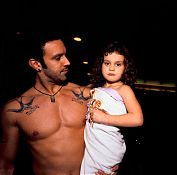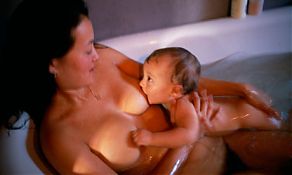Photographer Nan Goldin’s best shots’
I let the children be themselves, and try to find out who they are’
Interview by Sarah Phillips guardian.co.uk, Sunday 24 July
I don’t photograph adults so much any more. I don’t have a child and, psychologically, my focus on them is a lot about me wishing that I did. But I am a godmother to friends’ children around the world – in Berlin, New York, Sweden and Italy. I don’t remember much ever feeling like a child, so maybe photographing them triggers memories. They are wild and magical, as if from another planet. And they haven’t been socially conditioned yet, so they can scream and express how they feel publicly. Sometimes I envy them. When I am in a group of people, the children and I find each other’s eyes, and end up laughing at the same, unspoken thing.
I’ve been taking pictures of children since the early 1980s, and it’s become increasingly important to me. I see a continuum in the children of my friends, some of whom have died. It’s about hoping that my friends will bring up a new species of people.
Slideshows are my most important medium; they are like films that can constantly be edited. They always grow, as I show them over a period of years. These pictures are from the second version of a slideshow that was first shown last year in Athens. The images are edited and timed to a soundtrack. The music came first: all the songs are sung by children except the first, which is about pregnancy.
This is one of my most optimistic works: not concentrated on loss, death or darkness. With other pieces, I have wanted people to faint, throw up or cry. I’ve also wanted to touch them and make them laugh. Here, I don’t want people to faint or throw up. But I do want them to take away something about this puritanical new witch hunt over children and their sexuality. Everybody came out of the body of a woman, and that should not be forgotten, or be frightening. It amazes me that there’s a controversy over public breastfeeding, that it can be considered disgusting. Or over children running around naked, especially in the US. Children shouldn’t be afraid of their own bodies; it’s the worst thing you can do to a human being.
‘I’m very interested in their relationships with their parents’. Photograph: Nan Goldin
The pictures are both recent and from my archive. They are all children I know: my nephew; the new twins of my friend Amanda, whom I have photographed since 1989. There are a lot of pictures of Bruno, the boy with a temporary tattoo, the son of a friend. I just found a new picture of him looking very sad, which really touches me.
Generally, they love being photographed. I never set anything up, which people find impossible to believe, but it’s true. I let the children just be themselves, and try to find out who they are, then go as far as I can with that. I’m interested in how little children identify themselves by gender. I think for them it’s fluid. I’m interested in the melancholy I see, and the way children retreat into their own world. I’m very interested in their relationships to their parents – whether it is obvious that they are close, or ambivalent. There is one song about an incredibly loving son who doesn’t want his mother to strip: he wants to take care of her.
I like the ones where kids dress themselves up. Probably my favourite picture in the slideshow is of my goddaughter Klara, standing on a paint can singing, with scarves wrapped around her. Whenever I went to visit, she and her sister put on costumes, then did a performance for me. The child in camouflage was born a girl but chose to grow up as a boy, then changed again at 15. That little one peeping through the hole reminds me so much of myself, hiding but wanting to see. The baby on the blue pillow was about a month old, and the look that baby gave me: that kid knew everything. Some people say that children know it all and life is about forgetting, and maybe that’s true. They know something we don’t, because they just came out of the womb.
I wanted to show the whole process of development, so I have included babies before they were born, like my pregnant friend laughing in the bath tub. She gave birth that night, after I left, and I like the idea that the flash brought the baby out.
I don’t carry my camera so much these days: I don’t have the same relationship with it. I’ve never considered photography one of the higher art forms. Everyone takes photos; now even phones can. The whole issue of digital is so depressing to me; my process is gone. There were all kinds of unknown things that could come out in a photograph, things you didn’t know were there until you saw it; now it’s all so flat. But then I never really saw myself as a photographer.
‘She was born a girl but chose to grow up as a boy’. Photograph: Nan Goldin I certainly think that my work comes from a humanistic vision of the world, rather than some kind of manipulative, theoretical version of art. It’s about the people and places I love, and that haunt me.CV
Influences: When I was starting out, John Cassavetes, Guy Bordin and August Sander. Now, Christer Stromholm and Anders Petersen.
Top tip: Don’t do it. There are way too many photographers. Try to draw or get politically involved in something that matters. And unless you need to make art to stay alive, you shouldn’t be making art.
High point: I appreciated everything as it came along – I didn’t know there would be more. But the retrospective at the Whitney in 1996, the last book I did, The Beautiful Smile, and my show at the Louvre were real high points.
Low point: The past seven years: I haven’t been able to publish a book because of a contract, and have been considered a dead artist.

